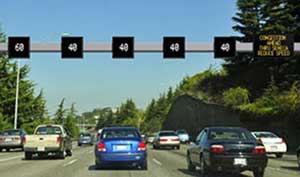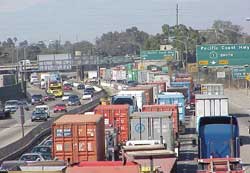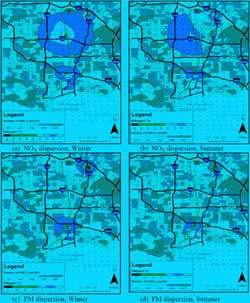Our consortium focuses on three themes identified by USDOT in its strategic plan—environmental sustainability, economic competitiveness, and livability—and, importantly, the connections between them. Advancing each of these objectives is important in and of itself; however, our UTC recognizes that the three are closely inter-twined and oftentimes co-dependent. Our UTC will thus give particular attention to the synergies that can be created and cross purposes that are served when working in a coordinated fashion on all three fronts.
The choice of these three themes reflects the breadth, depth, and wealth of knowledge and research capacities found across the six core members of our consortium. There is no better intellectual environment for conducting cutting-edge research and advancing basic and applied knowledge in these areas than across the campuses of the University of California. Our three themes are also highly relevant to the multitude of contemporary policy and technological challenges currently facing the transportation sectors of California and other southwestern states. We aim to be the “Go To” organization for federal modal administrations, California agencies, and policy-makers throughout Region 9 seeking well-informed advice, carefully designed research investigations, and rapid-response studies on these and related topics.
 California is a particularly appropriate setting for focusing on the three strategic themes chosen by our consortium. Currently, California makes up 12 percent of the nation’s population and contributes to 13.3 percent of its GDP, exceeding the economic output of all of Italy. The state’s ecological footprint is also enormous. Only the US as a whole and China consume more oil than California. Presently, the typical Californian produces 11 tons of carbon dioxide per year, nearly half coming from the transport sector, making California the world’s 12th largest source of greenhouse gas (GHG) emissions. The state is also home to the six smoggiest air basins in the nation. California, however, is also internationally known as an incubator of innovation and progressive change. It has long been a national leader in enacting legislation that protects natural environments, promotes clean-fuel technologies, and shrinks the transportation sector’s carbon footprint. California’s Global Warming Solutions Act (Assembly Bill 32), passed in 2006, calls for reducing carbon dioxide emissions to 1990 levels by 2020. A companion bill, Senate Bill 375, specifically targets the integration of transportation and land-use systems as a tool for achieving AB 32 GHG-reduction targets. Under the bill, metropolitan areas throughout the state must introduce strategies that curb sprawl and promote less carbon-intensive built forms like transit-oriented development (TOD). Both the marketplace and public policies are responding. Today, California has more plug-in hybrids, CNG buses, miles of High-Occupancy Vehicle (HOV), Toll (HOT), and management lanes, and weekly vanpoolers than any state. What we do in California is of huge importance, not just to Californians, but also the nation and entire world.
California is a particularly appropriate setting for focusing on the three strategic themes chosen by our consortium. Currently, California makes up 12 percent of the nation’s population and contributes to 13.3 percent of its GDP, exceeding the economic output of all of Italy. The state’s ecological footprint is also enormous. Only the US as a whole and China consume more oil than California. Presently, the typical Californian produces 11 tons of carbon dioxide per year, nearly half coming from the transport sector, making California the world’s 12th largest source of greenhouse gas (GHG) emissions. The state is also home to the six smoggiest air basins in the nation. California, however, is also internationally known as an incubator of innovation and progressive change. It has long been a national leader in enacting legislation that protects natural environments, promotes clean-fuel technologies, and shrinks the transportation sector’s carbon footprint. California’s Global Warming Solutions Act (Assembly Bill 32), passed in 2006, calls for reducing carbon dioxide emissions to 1990 levels by 2020. A companion bill, Senate Bill 375, specifically targets the integration of transportation and land-use systems as a tool for achieving AB 32 GHG-reduction targets. Under the bill, metropolitan areas throughout the state must introduce strategies that curb sprawl and promote less carbon-intensive built forms like transit-oriented development (TOD). Both the marketplace and public policies are responding. Today, California has more plug-in hybrids, CNG buses, miles of High-Occupancy Vehicle (HOV), Toll (HOT), and management lanes, and weekly vanpoolers than any state. What we do in California is of huge importance, not just to Californians, but also the nation and entire world.
 As the gateway to the Pacific Rim, California is also a vital link in the movement of freight and goods throughout America. The ports of Los Angeles and Long Beach are the nation’s busiest. The state’s two largest airports, LAX and SFO, rank in the top 10 of total annual enplanements. Expediting the flow of freight and materials in and out of ports in ways that promote economic growth without harming natural and built environments or disadvantaged communities poses both logistical and public-policy challenges. Intra- and interstate commerce will only pick up if and when the planned High Speed Rail through the spine of the state gets built. Our consortium is up to the task of tackling the kinds of technological and public-policy challenges posed by large-scale infrastructure investments, now and in the future.
As the gateway to the Pacific Rim, California is also a vital link in the movement of freight and goods throughout America. The ports of Los Angeles and Long Beach are the nation’s busiest. The state’s two largest airports, LAX and SFO, rank in the top 10 of total annual enplanements. Expediting the flow of freight and materials in and out of ports in ways that promote economic growth without harming natural and built environments or disadvantaged communities poses both logistical and public-policy challenges. Intra- and interstate commerce will only pick up if and when the planned High Speed Rail through the spine of the state gets built. Our consortium is up to the task of tackling the kinds of technological and public-policy challenges posed by large-scale infrastructure investments, now and in the future.
Below, we elaborate on the three strategic themes and the kind of attention and focus our consortium plans to give them.
Environmental sustainability is vital for creating clean, healthy, and functional cities and regions of the future. The transport of people and goods consumes nearly three-quarters of the nation’s petroleum, emits around a third of greenhouse gases, and is responsible for around half of urban air pollution. Fossil fuel-based travel also negatively impacts air quality, water quality, and habitat quality, with serious implications for economic well-being, human health, natural ecologies, and the long-term environmental sustainability of the planet. Finding ways to shrink the sector’s ecological footprint are national, state, and local priorities.
Our consortium is well-positioned to take on these challenges. As one of the world’s preeminent loci for advanced research and education on environmental sustainability, UC campuses have provided critical knowledge and modeling tools that underpin an array of transport-related GHG-reduction policies and laws. In the case of low-carbon fuel standards, California’s governor formally requested assistance from UC via an Executive Order to develop a policy to reduce the carbon intensity of transportation fuels. A team of UC Berkeley and UC Davis researchers carried out original scientific research and then designed a draft low-carbon fuel standard to meet a host of economic, social equity, legal, and administrative objectives. It was adopted in nearly identical form to what was recommended and is now being imitated by a large number of states and countries, including British Columbia, the northeastern and mid-Atlantic states, and the European Union. California’s Air Resources Board (ARB) also requested UC to evaluate the design of a fee-bate program (whereby consumers pay a fee when buying a gas guzzler car and receive a rebate for an efficient car). That analysis, headed by ITS-Davis, is now under consideration by the State.
 Technological advances, such as clean-fuel vehicles and intelligent transportation systems (ITS) that improve traffic flows, are part of the solution for creating sustainable futures. However, so are strategies that moderate the growth in vehicular travel without reducing the nation’s continually growing demand for social and economic interaction. More policy-oriented strategies that complement technological ones include demand management techniques, such as improved pricing and management of parking, eco-driving, as well as land-use approaches, such as TOD, that promote alternative means of travel. UC researchers have been providing support to the California ARB and other agencies on synthesizing the evidence and developing tools for forecasting the effectiveness of such strategies.
Technological advances, such as clean-fuel vehicles and intelligent transportation systems (ITS) that improve traffic flows, are part of the solution for creating sustainable futures. However, so are strategies that moderate the growth in vehicular travel without reducing the nation’s continually growing demand for social and economic interaction. More policy-oriented strategies that complement technological ones include demand management techniques, such as improved pricing and management of parking, eco-driving, as well as land-use approaches, such as TOD, that promote alternative means of travel. UC researchers have been providing support to the California ARB and other agencies on synthesizing the evidence and developing tools for forecasting the effectiveness of such strategies.
The pitting of technological and more policy oriented strategies as an “either/or” proposition is, we believe, a false dichotomy. Advances are needed on both fronts. Electric vehicle (EV) technologies and smart growth communities, for example, are wholly compatible. Limited-range EVs/plug-in hybrids are particularly well-suited to compact, mixed-use communities that shorten travel distances. Modern technologies (e.g., global positioning systems and automatic vehicle location) enable real-time dynamic pricing tied to vehicle-miles traveled (VMT) and congestion levels and at the same time can strengthen the social, economic, and cultural vibrancy of core cities. Central London, Singapore, and Stockholm have not suffered from the introduction of higher peak-period tolls. Or take the case of smart-parking technologies. An estimated 25 percent of all traffic in some districts of San Francisco and Los Angeles is made up of motorists cruising for parking. Smart technologies (e.g., sensors in parking spaces that monitor occupancy) can reduce such cruising, inform motorists of the closest available space, and allow dynamic pricing of parking (i.e., higher fees in congested times; lower ones in slack periods). Such technologies not only shrink parking’s enormous footprint, but also improve the quality of urban environments and in so doing encourage less carbon-intensive modes of travel, including walking and cycling.
Economic competitiveness has always been a core focus of transportation planning and engineering since efficient transportation systems and operations are vital toward sustained economic growth and prosperity. The nation’s economy relies crucially on its systems of highways, ports, and mass transportation to swiftly and safely move raw materials, labor, manufactured products, component parts, and ideas to produce and exchange goods and services. Bottlenecks on highways leading to and from ports, unreliable mass transit systems, and deteriorating traffic conditions can strangle economic growth and, if left unchecked, place America’s cities and regions at a global economic disadvantage. In 2009, the congestion “invoice” for the extra time and fuel spent moving people and goods in America’s 439 urban areas reached $115 billion. Policy-makers well understand this. The Economist Intelligence Unit Global Survey, released in September 2010, reported that 61 percent of mayors worldwide believed that “improving public transport and roads” is the most important way “to make their cities more competitive for businesses.” As home to the busiest port in the nation and four of America’s 22 most congested urbanized areas, California has a vested economic stake in planning, designing, operating, managing, and pricing multi-modal transportation facilities and services in the most efficient, resourceful way possible.
The University of California has established itself as an intellectual leader in such areas as traffic operations, intelligent transportation systems (ITS), and transportation/land-use integration. Major advances in the field of traffic flow theory originated at UC Berkeley, which has over the years spawned the world’s leading systems for traffic measurement through loop detectors (Caltrans Performance Measure System-PeMS) and video surveillance (developed at the Berkeley Highway Laboratory) as well as freeway traffic control through ramp-metering (Tools for Operational Planning-TOPL).
UC campuses also have an established track record at integrating travel-demand models in ways that inform and shape public policies. For example, UC Santa Barbara’s GIS-based travel forecasting tools (SimAGENT) and UC Irvine’s advanced traffic simulation models are being integrated to predict regional transportation flows, and in turn are being linked to UC Davis’s urban land-use model PECAS (Production Exchange Consumption Allocation System) to estimate impacts on fuel consumption and GHG emissions. Another successful collaboration has been the integration of advanced traffic monitoring technologies (based on GPS-enabled cellular phones) developed by UC Berkeley researchers with vehicle emission measurement tools developed at UC Riverside (and certified by USEPA and the California Air Resources Board as the gold standard for on-road testing).
Economic competitiveness is not just about moving people and freight swiftly, safely, and cleanly. Desirable and therefore competitive places are also socially inclusive and diverse. Equity concerns have been especially prominent in the research of UC scholars. UCLA researchers have examined the equity of road and transit pricing in comparison with other finance techniques commonly used to pay for transportation infrastructure and services. Studies have also shown that efforts to curb automobile use may help to clean the environment, but for many segments of society can lead to social exclusion and negative economic outcomes. Scholars from UCLA and UC Berkeley have published among the most widely cited work to date on topics like impacts of transportation programs on welfare-to-work, spatial mismatches and employment outcomes, and equity consequences of alternative road, parking, and transit pricing schemes.
Livability continues to gain importance as a national, state, and local goal because it is intimately related to social well-being, peoples’ attachment to community and place, and healthy living. Livable communities feature well-designed streetscapes, attractive civic spaces, the inter-mixing of land uses, “complete streets” that promote walking and cycling, and Safe Routes to School. Such environments are increasingly in high demand. We know this not only from public opinion polls but also real-estate markets. High-quality urban and suburban districts and well-designed places often command sizeable rent and land-value premiums. Importantly, the livability movement elevates accessibility, i.e., the ability of people to reach the places they wish to go, as an overarching goal in transportation planning and investment. Expediting traffic flows is certainly critical to creating accessible cities and regions, but so are urban designs that bring trip origins and destinations closer and information-technological advances that allow social and economic interactions without necessarily physical movements.
Scholars from several UC campuses, notably Santa Barbara, Irvine, Berkeley, and Davis, have developed state-of-the-art transportation land use models and other planning tools that gauge impacts of livability-sustainability scenarios on accessibility, community well-being, and social equity. The SimAGENT model, an activity-based forecasting model, was developed by scholars from UC Santa Barbara with the help of UCTC funding, and is being used to test GHG-reduction scenarios by the Southern California Association of Governments (SCAG) in response to California’s SB 375. Urban design work by scholars on the Berkeley and Los Angeles campuses has led to streetscape designs and multi-dimensional evaluation tools that enhance pedestrian and bicyclist comfort, safety, and connectivity. Over the years, seminal work on multi-way boulevards, complete and livable street designs, and freeway-to-boulevard/freeway-to-greenway conversions has come from UCTC-funded research. The effects of more efficient pricing on the quality of urban districts have also been studied. Widely cited research by UCLA scholars showed that parking policy reforms can have a strong positive effect on community betterment and local economic development, and are often the lynchpin to successful redevelopment investments. Researchers at UC Berkeley, UC Davis, and UC Irvine are international leaders in the study of the effect of community design and urban land-use patterns on travel behavior. Seminal and highly influential research on the travel-demand, environmental, and community development impacts of TOD, jobs-housing balance, neo-traditional community designs, urban containment policies, and other growth-management strategies has been carried out by scholars of our consortium.
Synergies exist and are waiting to be tapped into across the spheres of environmental sustainability, economic competitiveness, and livability. Our consortium will conduct the kinds of rigorous, grounded research that advances knowledge and trains future generations of transportation professionals not only within these domains but across them as well. Creating clean, livable cities, towns, and regions, for example, can be an effective economic development strategy—attractive and healthy living and working environments can attract and help retain high-skilled, high value-added firms, and workers of service-based economies. Cities and regions whose economies rely heavily on creative, knowledge-intensive industries, studies show, must design and build attractive cityscapes that promote active forms of mobility (e.g., walking and bicycling) and improve environmental conditions such as air quality if they are to successfully compete in the 21st century global marketplace. Similarly, relieving traffic congestion not only makes cities and regions more economically competitive but also enhances livability. Public opinion polls routinely show that worsening traffic congestion is the number-one reason cited for the perceived declining quality of urban living in the eyes of the American public. Well-designed cities and efficient pricing of infrastructure that helps slow the growth in VMT can also promote economic growth. The recent report on Growing Wealthier, for example, founded that states with lower VMT per capita tend to have higher GDP per capita. While correlations do not prove causality, and other researchers have reached opposite conclusions,5 most would agree that the aim should be less about encouraging physical movement and more about designing communities and pricing resources to maximize economic and social interactions.
The linkages between environmental sustainability and economic competitiveness, we believe, are especially important. Besides attracting high-skilled firms and creative classes of workers, global cities with clean air, generous amounts of public spaces, attractive urban designs, and functional transportation and infrastructure systems are excellent incubators for growing the green economy. Advances in the production and distribution of clean-fuel vehicles that operate on renewable energy sources can stimulate private investment and create new employment and vocational opportunities.
